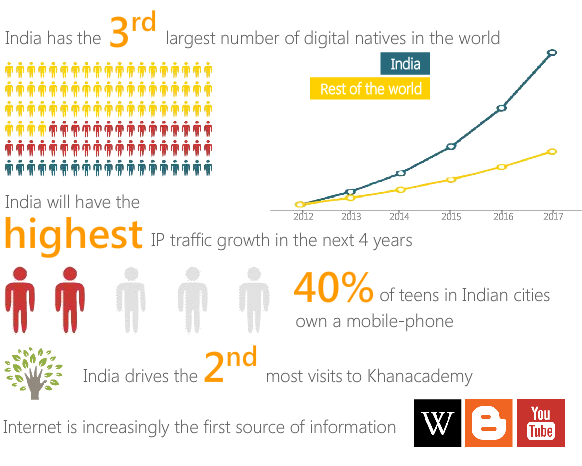Who are we?
Bank Bazaar | Party Gaming | IIT Kharagpur
Urbantouch.com | Deutsche Bank | IIT Kharagpur
explosive growth in ONLINE LEARNING

SUCCESS STORIES - ONLINE LEARNING
-
Coursera
-
Khan Academy
-
Udacity
-
Udemy
-
Lynda.com
- Knewton
Paradigm shifts in K-12 education

ACTIVE LEARNING

ACTIVE LEARNING = BETTER LEARNING

active learning through creation
- Bloom's taxonomy -

ACTIVE LEARNING THROUGH CREATION
- existing challenges -
- Time consuming
- Students need to spend significant time searching for the right resources
- Logistical challenges exist
-
Physical projects are resource intensive, difficult to manage, fragile & not editable
-
Difficult to fit in class schedule
-
Teachers find it difficult to fit active learning activities in existing schedules
ACTIVE LEARNING THROUGH CREATION
- easy creation using digital -
- Efficient
-
Create audio-visual presentations on on any topic in minutes.
Searchable digital library provides best digital resources for learning and preparation - Engaging
-
Students can use visual elements, animations or rap songs to get their point across
Digital medium allows for amazing creativity & innovation by students
-
Minimal requirements
-
All you need is a device with a web browser - PC, tablet or smartphone
-
Complements classroom teaching
-
Does not disrupt teacher's schedule. Implement in class or assign as after-class
A ROAD-MAP for better learning

SOKRATIK
SAMPLEs created using sokratik
How it works
- better learning via storytelling -
HOW it works
1. TEACHER INTRODUCES New CONCEPT

how it works
2. students are Assigned PROJECTS

HOW IT WORKS
3. STUDENTS EXPLORE & learn
Students access the Sokratik digital library to explore & learn

how it works
4. students plan & structure stories
how it works
5. students record audio
how it works
6. students SHARE with peers & teacher

SOKRATIK FOR SCHOOLS
TEACH WITH SOKRATIK
REFERENCES
[2] President's Council of Advisors on Science and Technology (2012) Engage to excel: Producing 1 million additional graduates with degrees in science, technology, engineering & mathematics
[3] Prince, M. (2004). Does active learning work? A review of the research . Journal of engineering education 93(3) 223-231
[4] Westermann, K. & Rummel, N. (2012) Delaying instruction: evidence from a study in a university relearning setting. Instructional Science 40(4), 673 -689
[5] Chi, M.T.H., de Leeuw N., Chiu M.H. & LaVancher,C. 1994: Eliciting self-explanations improves understanding. Cog Sci 18: 438–477
[6] Chi, M. T. H., Bassok, M., Lewis, M. W., Reimann, P., & Glaser, R. (1989). Self-explanations: How students study and use examples in learning to solve problems.


